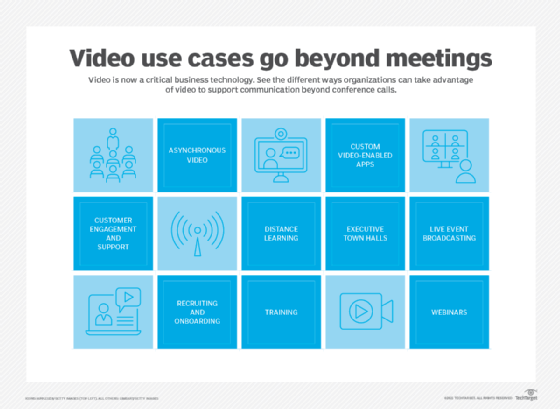
Getty Images/iStockphoto
New forms of enterprise video spark management challenges
Video conferencing is now a fundamental part of employees' workdays. But managing and storing video content brings some new challenges that must be addressed.
Thanks in large part to the COVID-19 pandemic, video conferencing is now a staple of enterprise communications. Today, more than 60% of enterprises use video for most or all meetings, according to Metrigy's "Unified Communications Management and Endpoints: 2021-22" global study of nearly 400 companies. Almost four in 10 respondents said video is a critical technology for operating their business.
The use cases for enterprise video are rapidly expanding beyond meetings. Consider the following:
- More than 90% of companies conduct webinars, typically using video to let speakers communicate more effectively than merely sharing slides.
- More than 40% said they were using, or planning to use, video streaming internally for broadcasts, executive town halls and anchoring distance learning and training, according to Metrigy's "Visual Communications and Collaboration" study of more than 500 organizations.
- More than 41% were developing, or planning to develop, their own custom video apps using toolkits, communications platform as a service or APIs available from their video meeting vendors, according to the same study.
- More than 70% are using, or planning to deploy, video for either one- or two-way customer engagement, making video the fastest-growing contact center channel.
- Collaboration application vendors have made it possible for employees to easily create and share short videos as an alternative to typing messages or leaving voicemails.
Use cases for video continue to expand, from the use of drones to survey powerlines to "show me what you see" applications designed to improve customer service and support.
Key challenges emerging
Yet, companies face two key challenges in their plans to make enterprise video a key component in their digital transformation strategies: storage and security.
Video requires a great deal of storage, with many individual recordings totaling gigabits in size. For many companies, the answer is to store these files no differently than they store other data, such as documents and images. But enterprises are quickly finding that storing video is expensive and that it creates unanticipated demands on capacity.

On the security front, video created via meeting recordings, broadcasts and other use cases typically requires a specific governance strategy, especially for regulated industries. Examples include the need to classify video and to comb through video and transcripts to uncover any vulnerabilities that could lead to data loss. In addition, companies must control access to stored video content, especially when it may contain personally identifiable information or other sensitive data.
Today, about 70% of companies manage the sharing of recorded video. Approaches widely vary and may include delegating review responsibilities to individual departments.
Optimizing video management
Companies with video storage and security requirements typically start by evaluating enterprise video content management systems. These purpose-built applications, among vendors such as Brightcove, IBM, Kaltura, MediaPlatform, Microsoft, Panopto, Qumu and Vbrick, typically offer a mix of on-premises or cloud storage options, as well as the ability to implement access controls to support security. Most vendors enable creation of YouTube-like channels to let employees access videos relevant to them and to view video transcripts. Several also include workflow support for approval processes.
Companies with specific governance and data loss protection needs may consider tools from vendors, such as Theta Lake, to automate scanning of video to ensure compliance and to protect against security threats.
Successfully supporting a wide variety of video use cases requires companies to proactively address storage and security needs. Evaluate platforms that optimize your video asset management and ensure you are protected against data loss and compliance risks.







